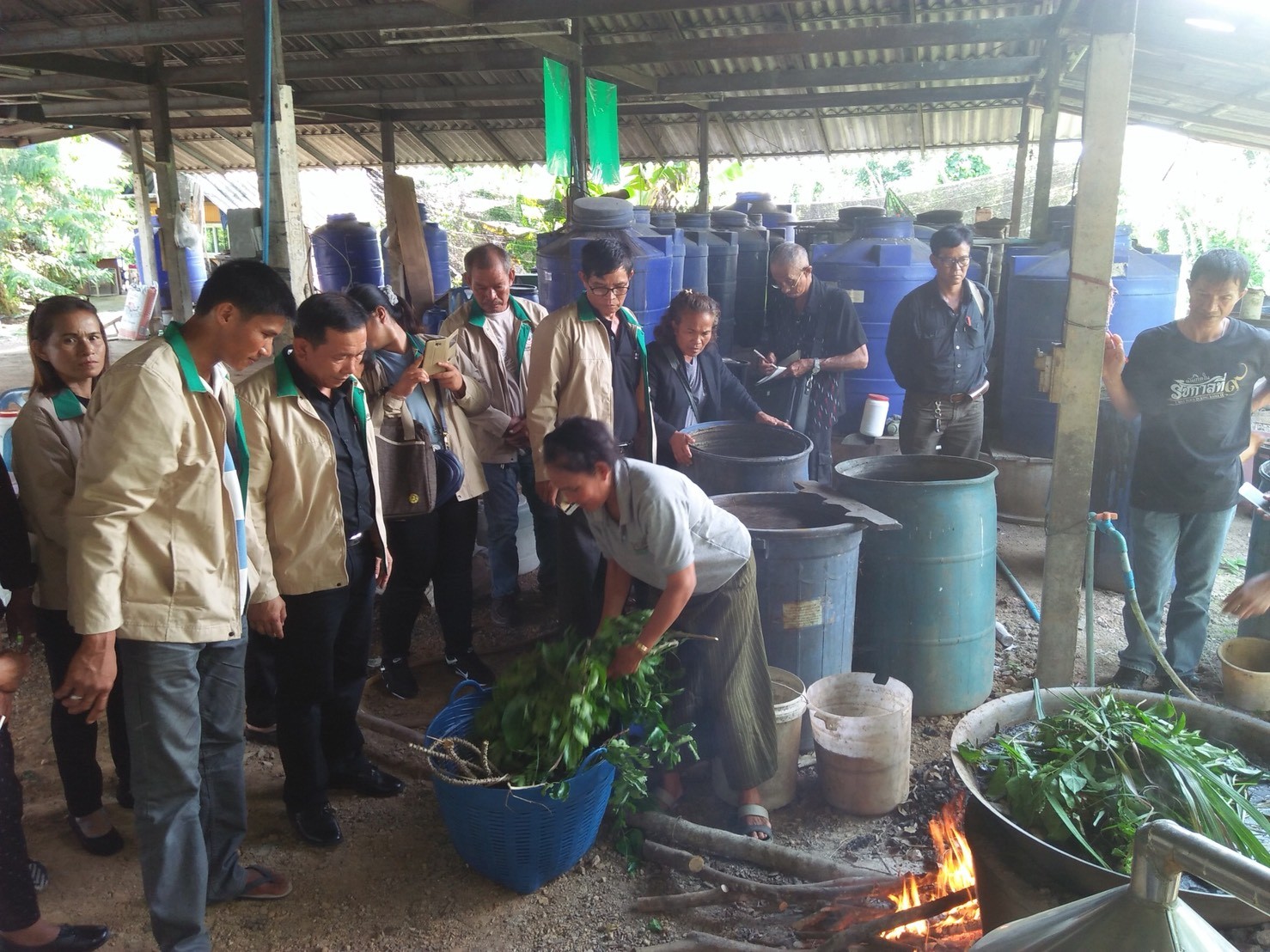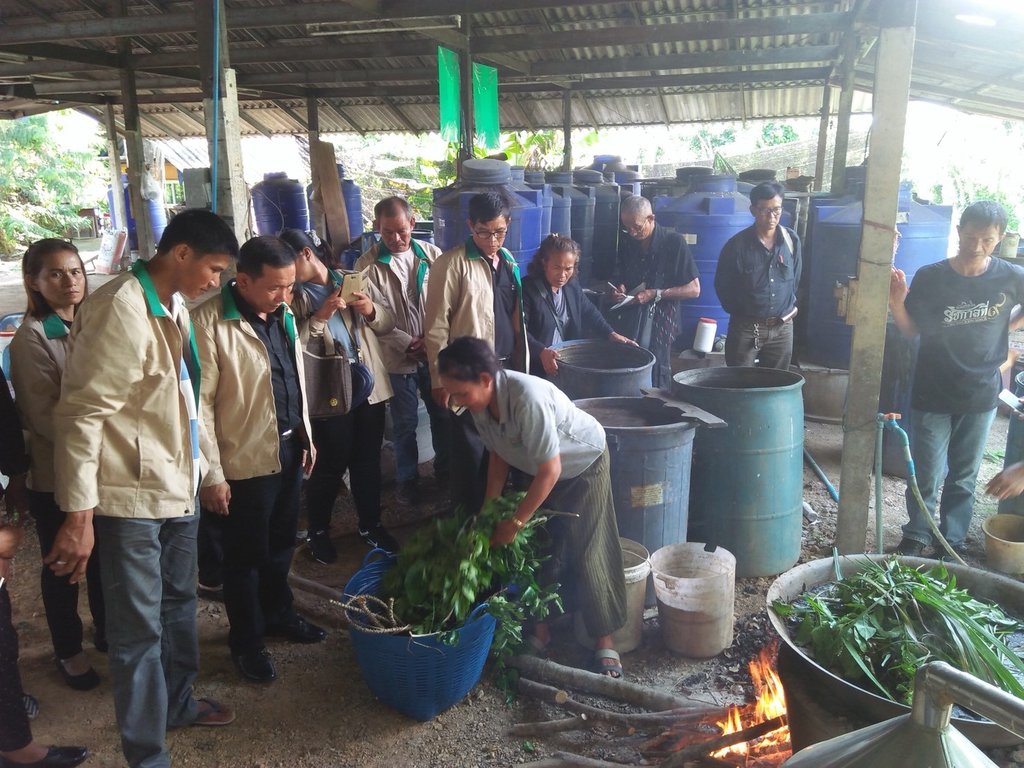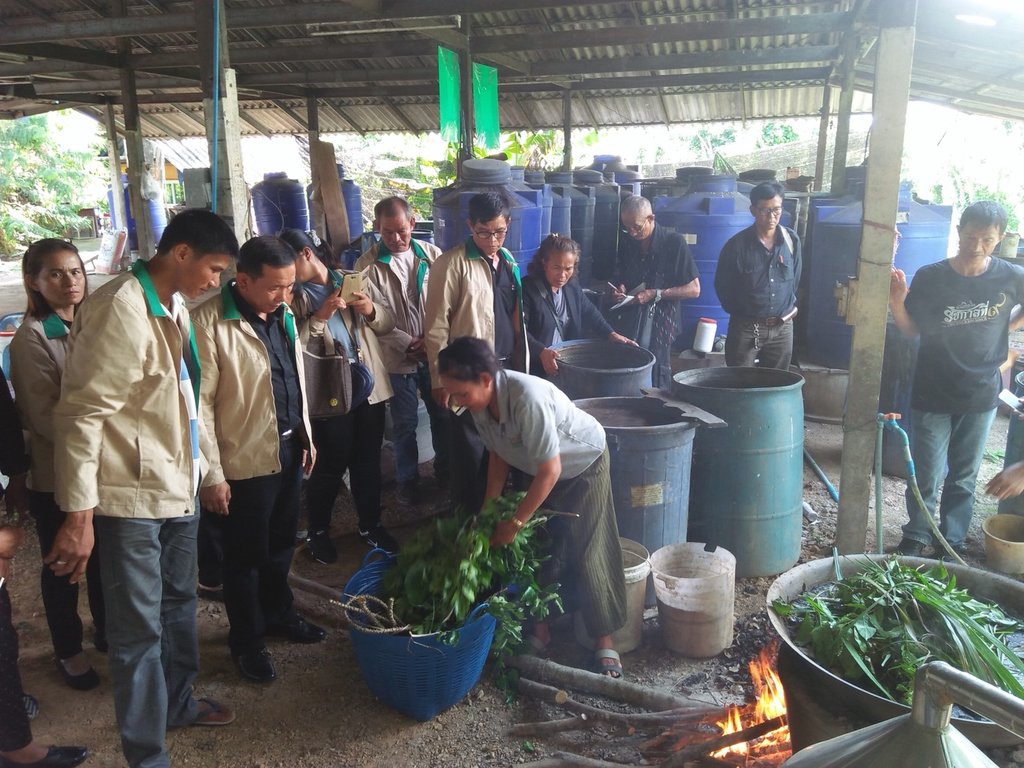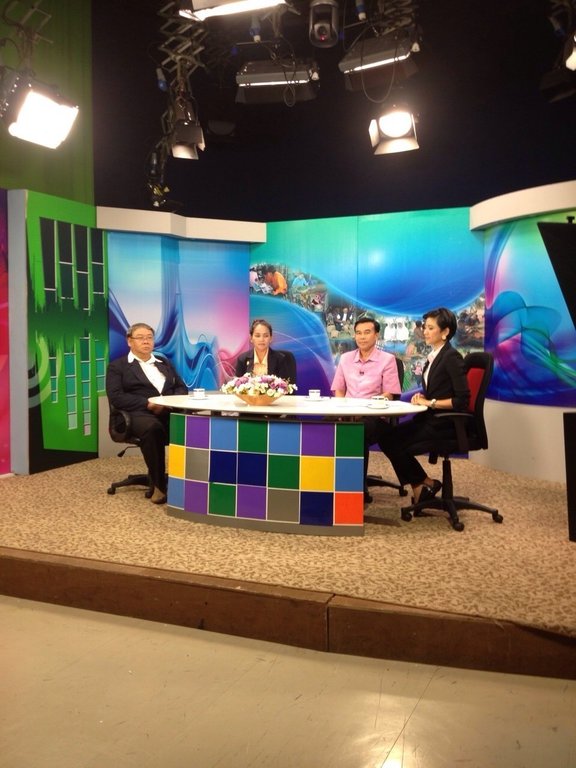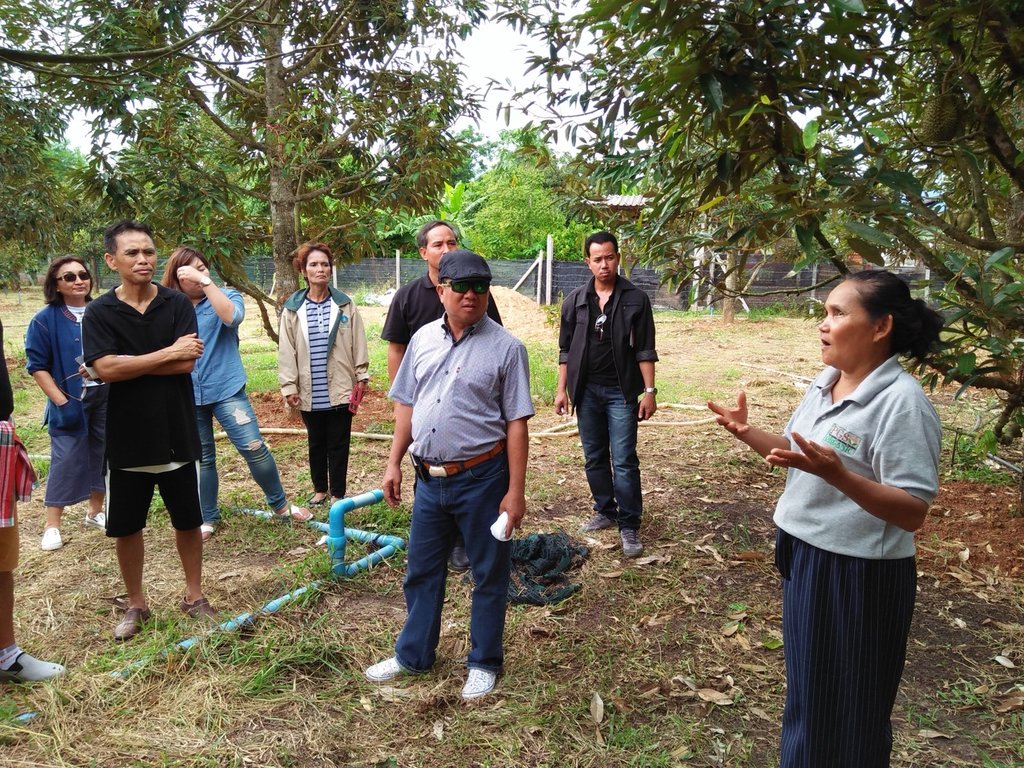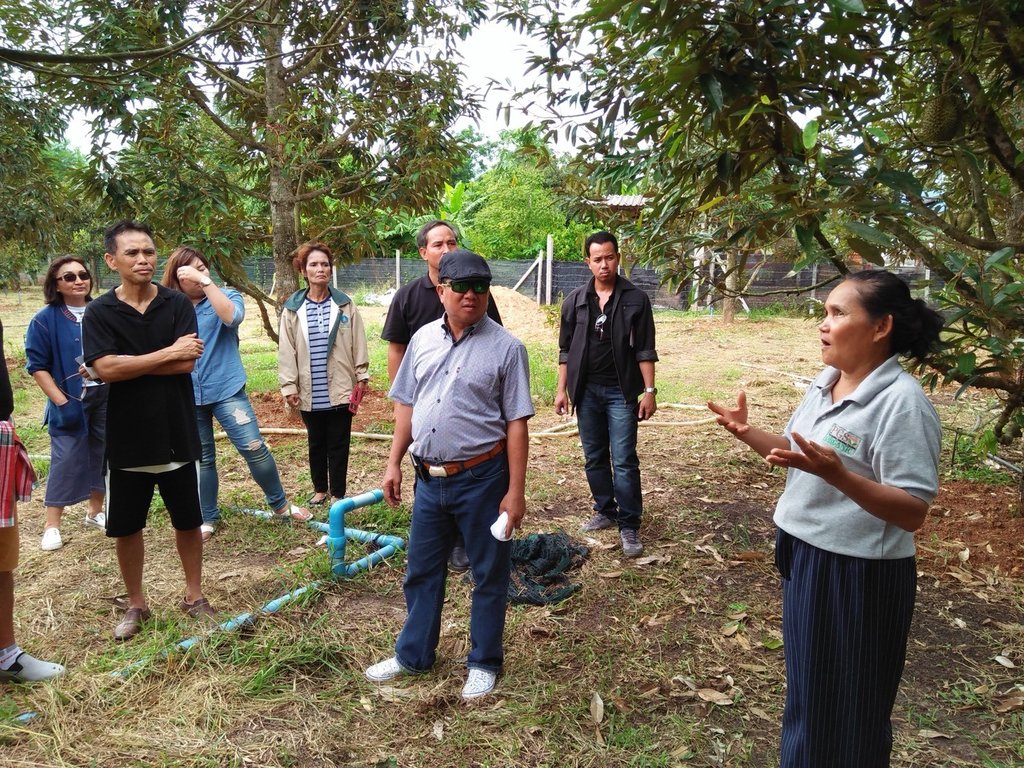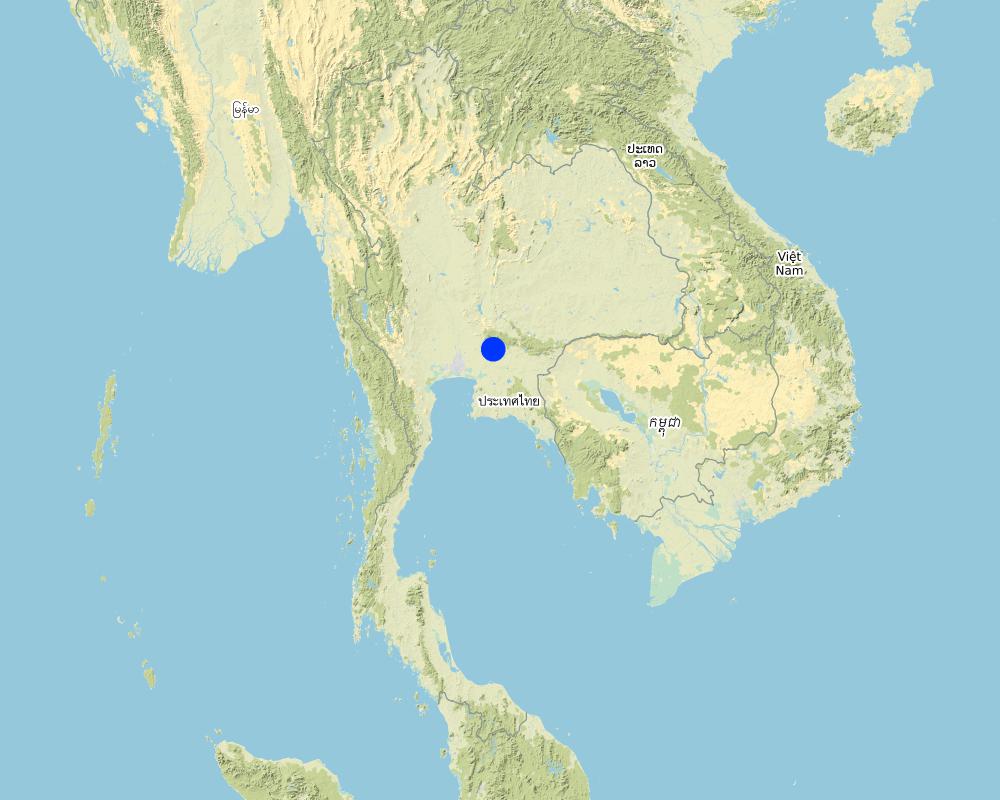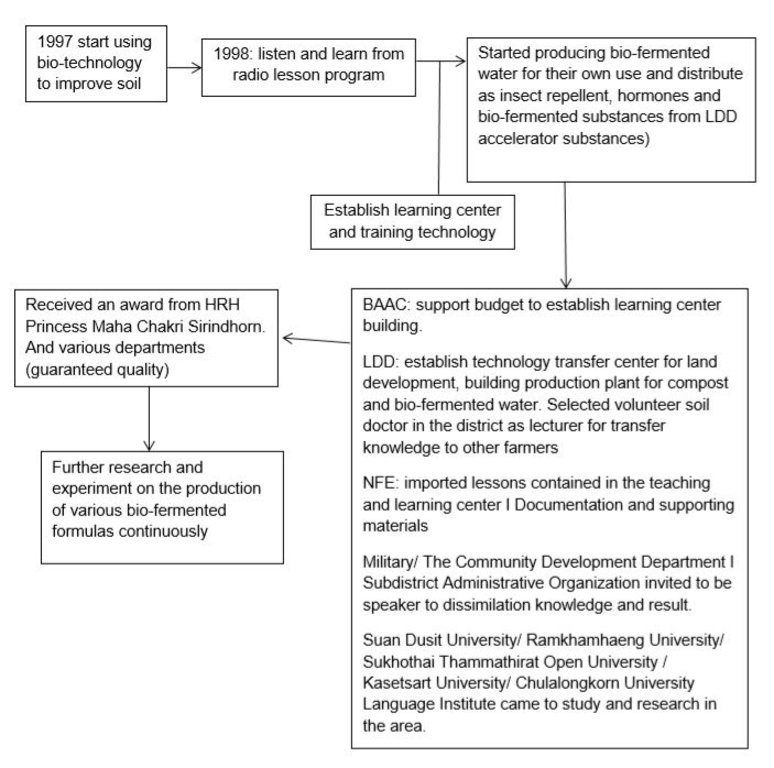The Bio-fermentation technology Transferring Centre for the Soil Improvement [Thailand]
- Creation:
- Update:
- Compiler: Kukiat SOITONG
- Editor: –
- Reviewers: Rima Mekdaschi Studer, William Critchley
Land Development Learning Centre at Mai ket district
approaches_4234 - Thailand
View sections
Expand all Collapse all1. General information
1.2 Contact details of resource persons and institutions involved in the assessment and documentation of the Approach
Key resource person(s)
land user:
ผู้รวบรวม:
ไผผักแว่น นางสาวปาริชาติ
0-3721-0781 / 08-5920-8429
parichat19@hotmail.com / -
สถานีพัฒนาที่ดินปราจีนบุรี สำนักงานพัฒนาที่ดินเขต 2 กรมพัฒนาที่ดิน
135/1 ม. 5 ต. เนินหอม อ. เมือง จ.ปราจีนบุรี 25230
Thailand
land user:
ผู้อำนวยการศูนย์การศึกษานอกระบบและการศึกษาตามอัธยาศัยอำเภอเมืองปราจีนบุรี ผู้นำแนวทางเอสแอลเอ็ม ไปถอดบทเรียนเพื่อจัดทำหลักสูตรการเรียนการสอน และหลักสูตรการฝึกอบรมในองค์กร และเผยแพร่ประชาสัมพันธ์:
เหล่าวงศ์วัฒนา นายสมบูรณ์
0-3721-3261 / 08-1723-0421
- / -
ศูนย์การศึกษานอกระบบและการศึกษาตามอัธยาศัยอำเภอเมืองปราจีนบุรี
ที่อยู่องค์กร ถนนราษฎรดำริ ซอย 5 ต. หน้าเมือง อำเภอ เมืองปราจีนบุรี จังหวัด ปราจีนบุรี รหัสไปรษณีย์ 25230
Thailand
ด้วงพิมพ์ นายกนก
09-5253-5982 / -
- / -
สวนเติมทรัพย์ไม้เค็ดโฮมสเตย์
27/2 ม. 2 ต. ไม้เค็ด อ.เมือง จ. ปราจีนบุรี
Thailand
land user:
พุ่มสุข นางอรุญ
09-8893-0860 / -
- / -
เกษตรกร
42/2 ม. 5 ต. ไม้เค็ด อ. เมือง จ. ปราจีนบุรี
Thailand
land user:
บุญยงค์ จ.ส.อ.แมน
08-7128-7051 / -
- / -
ร.2 พัน.1 รอ.
45/2 ม.5 ต.ไม้เค็ด อ. เมือง จ. ปราจีนบุรี
Thailand
บุญยงค์ จ.ส.อ.แมน
08-7128-7051 / -
- / -
ร.2 พัน.1 รอ.
45/2 ม.5 ต.ไม้เค็ด อ. เมือง จ. ปราจีนบุรี
1.3 Conditions regarding the use of data documented through WOCAT
When were the data compiled (in the field)?
28/09/2018
The compiler and key resource person(s) accept the conditions regarding the use of data documented through WOCAT:
Ja
2. Description of the SLM Approach
2.1 Short description of the Approach
The Bio-fermentation technology Transferring Centre for the Soil Improvement at Mai ket district is a source of learning about the production and the usage of the bio-fermented solution to improve the soil and create a farmers’ network on quality crop production.
2.2 Detailed description of the Approach
Detailed description of the Approach:
The Bio-fermentation technology Transferring Centre for the Soil Improvement at Mai ket district, Muang Prachin Buri is the source of learning about the production and usage of the bio-fermented water in soil degradation deteriorated and improve especially in the sandy soil which has the low abundance. The owners of the centre are knowledgeable, expert, and researchers and proud of the research and technology succession and they are ready to transfer that knowledge to the farmers in neighbouring communities by showing the source / demonstration plots which can come to study / visit / see the work. There are the transmission processes that they have the ability to be as the lecturers.
The purpose of the Bio-fermentation technology Transferring Centre for Soil Improvement is to convey the technology of production and use of bio-fermented solution to the farmers and the general public to build a network of users of the biotechnology to improve the soil.
The Bio-fermentation technology Transferring Centre for Soil Improvement has the working processions are following:
1. Studying and doing the research (experimental) of the bio-fermented water.
2. Technology transferring of the meeting, observing the exhibition, printing media, radio/TV program
3. Creating the Networking
4. Promoting the work
5. Selling the products such as durian or durian products, vegetable (Climbing Wattle)
6. Organizing the outside exhibition (Foundation Day, Department of Land Development, 2017)
The working processions of The Bio-fermentation technology Transferring Centre for Soil Improvement
1. Selecting the farmers who are successful in producing and using Bio-fermentation technology and improvement of soil degradation that established as a technology transferring centre and provide operational support by the Department of Land Development.
2. Promote the public relations to the broadcast centre such as the installation of the PR centre. VDO photography on Youtube, TV shows, radio programs.
3. Develop e the learning points and demonstration plots, including learning points / demonstrations of biological fermentation. Composting Quality of fruit trees Pest control by supporting inputs from the government.
4. Provide training to visit by government agencies, the private and educational institutions. Provide the supporting or farmers interested in self studying as well as being a lecturer both on and off the premises.
5. The Bio-fermentation technology user network is established to improve the soil and produce the quality crops from farmers who come to study. The government has provided the supporting to strengthen to the group / network from learning, such as providing knowledge, supporting inputs as taking to learn.
6. Provide a learning forum to result in technology exchanging by Learning together and technology transferring.
7. Promote and develop the production and usage of biotechnology such as the development of bio-fermented formulas to suit the application.
8. Selling products such as seedling (durian), product (durian, longkong, banana, climbing wattle, etc.) biological extract.
The relevant people of the working processions of The Bio-fermentation technology Transferring Centre for Soil Improvement
- The farmer who is the owner of the centre has the role of researching, experimenting and developing technology, lesson learned / technological knowledge, technology transferring management and development centre.
- The group of students who included the general farmers, the expert of the soil, student / university student and the government officers.
- The group / Network Manufacturers and users of technology which learn how to buy and sell.
- Consumers / customers include farmers and the general public that buy the fruits / fruits / vegetables and various extracts.
- Promoters (budget, inputs, dissemination, exhibition, study, visit) such as the government officers. (Military / civilian / teacher) are massive media.
-The centre of broadcasting that is a great way to learn how to practice to solve problems in the occupation.
- Farmer Centre owner is the researcher. It is a prototype farm for interested farmers.
- Ensuring the professionalism of the technology user community. (The network provides advice / guidance, such as the formula to produce the benefits.
- Make the opportunity to meet and exchange to each other.
The limited of The Bio-fermentation technology Transferring Centre for Soil Improvement is
- Learning Points / Learning base on the relay centre is rare. It should increase the learning points and participation from relevant agencies.
2.3 Photos of the Approach
2.4 Videos of the Approach
Comments, short description:
การใช้เทคโนโลยีชีวภาพเพื่อการพัฒนาที่ดิน
Date:
07/03/2018
Location:
-
Name of videographer:
กรมพัฒนาที่ดิน
Comments, short description:
หมอดินอาสา ต้นแบบวิถีเกษตรอินทรีย์
Date:
05/07/2016
Location:
-
Name of videographer:
กรมพัฒนาที่ดิน
2.5 Country/ region/ locations where the Approach has been applied
Country:
Thailand
Region/ State/ Province:
ปราจีนบุรี
Further specification of location:
62/1 ม. 5 ต.ไม้เค็ด อ. เมือง จ. ปราจีนบุรี
Comments:
-
Map
×2.6 Dates of initiation and termination of the Approach
Indicate year of initiation:
2000
Comments:
ริเริ่มถอดบทเรียนตั้งปี 2543 ผ่านทางสื่อวิทยุของกองพลทหารราบ
2.7 Type of Approach
- recent local initiative/ innovative
2.8 Main aims/ objectives of the Approach
ศูนย์ถ่ายทอดเทคโนโลยีชีวภาพเพื่อการปรับปรุงบำรุงดิน มีวัตถุประสงค์เพื่อถ่ายทอดเทคโนโลยีการผลิตและการใช้น้ำหมักชีวภาพ ให้กับเกษตรกรและผู้สนใจทั่วไปและเพื่อสร้างเครือข่ายผู้ใช้เทคโนโลยีชีวภาพในการปรับปรุงบำรุงดิน
2.9 Conditions enabling or hindering implementation of the Technology/ Technologies applied under the Approach
social/ cultural/ religious norms and values
- enabling
วัฒนธรรมในท้องถิ่นมีการช่วยเหลือเกื้อกูลซึ่งกันและกันกัน มีไรก็แบ่งปันกัน ดังนั้นเมื่อเกษตรกรประสบมีปัญหาในการทำการเกษตรสามารถสอบถามวิธีปฏิบัติที่ประสบความสำเร็จจากเกษตรกรต้นแบบได้
availability/ access to financial resources and services
- enabling
มีแหล่งเงินทุนสนับสนุน แต่เกษตรกรสามารถบริหารจัดการเงินทุนทางการเกษตรได้ด้วยตนเอง ไม่สนใจกู้เงินจากสถาบัน
institutional setting
- enabling
กรมพัฒนาที่ดิน.จัดตั้งเป็นศูนย์ถ่ายทอดเทคโนโลยีการพัฒนาที่ดิน ถ่ายทอดองค์ความรู้ จัดพิมพ์เอกสารเผยแพร่ ถ่ายทำวีดีทัศน์ และสนับสนุนงบประมาณเพื่อถ่ายทอดองค์ความรู้สู่เกษตรกร และ ชุมชนอย่างกว้างขวาง ศูนย์การศึกษานอกระบบและการศึกษาตามอัธยาศัยอำเภอเมือง จังหวัดปราจีนบุรี ธนาคารเพื่อการเกษตรและสหกรณ์การเกษตร กองพันทหารราบที่ 2 ถอดบทเรียนและถ่ายทอดความรู้ผ่านสื่อการเรียนการสอนและสื่อวิทยุ พร้อมสนับสสนุนงบประมาณอย่างกว้างขวางและวัสดุอุปกรณ์ที่จำเป็น
legal framework (land tenure, land and water use rights)
- enabling
กรมพัฒนาที่ดิน และหน่วยงานกระทรวงเกษตรและสหกรณ์ สนับสนุนงบประมาณ และปัจจัยการผลิต ในการฝึกอบรม ให้แก่เกษตรกร
policies
- enabling
ส่งเสริมให้เกษตรกรใช้สารอินทรีย์ชีวภาพ ลดการใช้สารเคมีทางการเกษตร อยู่แบบพอเพียง พึ่งพาตนเองได้ มีภูมิคุ้มกันตนเอง
land governance (decision-making, implementation and enforcement)
- enabling
ภาครัฐส่งเสริมการทำเกษตรอินทรีย์
ไม่เป็นระบบ ดูแลไม่ทั่วถึง ได้รับการสนับสนุนปัจจัย แต่เกษตรกรไม่มีความรู้ในเรื่อง การนำไปใช้ และการพัฒนาต่อยอด
knowledge about SLM, access to technical support
- enabling
ภาครัฐหลายหน่วยงาน พร้อมสนับสนุนและส่งเสริมการถ่ายทอดเทคโนโลยีสู่เกษตรกร และชุมชน
markets (to purchase inputs, sell products) and prices
- enabling
ตลาดรับซื้อผลผลิต ที่ให้ราคาสูง เนื่องจาก เพราะเป็นสินค้าเกษตรปลอดภัย
workload, availability of manpower
- enabling
การถ่ายเทคโนโลยีชีวภาพ สอนให้พึ่งพาตนเองได้ ใช้ปัจจัยภายในฟาร์ม ดังนั้นเกษตรกรมักใช้แรงงานตนเองในครัวเรือน มีการแจ้าง้งแรงงานน้อย ทำให้ลดต้นทุนการผลิต
3. Participation and roles of stakeholders involved
3.1 Stakeholders involved in the Approach and their roles
- local land users/ local communities
เกษตรกรในชุมชน พื้นที่ใไกล้เคียง และจากพื้นที่อื่นทั่วประเทศ
เดินทางมาเรียนรู้ ฝึกอบรม ศึกษาดูงาน ในศูนย์ฯ และนำความรู้ไปปฏิบัติในพื้นที่ของตนเอง
- community-based organizations
องค์กรปกครองส่วนท้อนถิ่น
พัฒนาพื้นที่ให้เป็นแหล่งท่องเที่ยวเชิงเกษตร
- SLM specialists/ agricultural advisers
กรมพัฒนาที่ดิน
คัดเลือกให้เป็นหมอดินอาสาประจำจังหวัดปราจีนบุรี และเชิญเป็นวิทยากรความรู้ ด้านการใช้เทคโนโลยีชีวภาพเพื่อการพัฒนาที่ดินแก่เกษตรกรและหมอดินอาสา
- teachers/ school children/ students
ศูนย์การศึกษานอกระบบและการศึกษาตามอัธยาศัยอำเภอเมือง จังหวัดปราจีนบุรี
ถอดบทเรียนด้านการใช้เทคโนโลยีชีวภาพเพื่อเพิ่มผลผลิตพืช และจัดทำเป็นหลักสูตรการเรียนการสอนของหน่วยงาน
- private sector
ธกส
สนับสนุนงบประมาณก่อสร้างอาคารศูนย์เรียนรู้
หน่วยงานพัฒนาของทหาร
-
If several stakeholders were involved, indicate lead agency:
-
3.2 Involvement of local land users/ local communities in the different phases of the Approach
| Involvement of local land users/ local communities | Specify who was involved and describe activities | |
|---|---|---|
| initiation/ motivation | self-mobilization | นางวันเพ็ญ สนลอย เผยแพร่แนวทางการดำเนินชีวิตของตนเอง ผ่านสื่อรายการวิทยุของหน่วยงานทหาร พ.ท. วีระ ใจหนักแน่น กรมพัฒนาที่ดินสนับสนุนเชื้อจุลินทรีย์สารเร่ง พด.2 กากน้ำตาล ถังหมัก |
| planning | interactive | กรมพัฒนาที่ดิน สนับสนุนปัจจัยการผลิต จัดตั้งศูนย์เรียนรู้ และเชิญเป็นวิทยากร กศน. สนับสนุนเอกสาร เชิญเป็นวิทยากร นำองค์ความรู้ไปขยายผลเคยออกรายการทีวี เรื่อง การใช้เทคโนโลยี เพื่อการทำการเกษตรที่ยั่งยืนหน่วยงานทหาร เชิญไปเป็นวิทยากรบรรยาย |
| implementation | interactive | พด. สนับสนุนงบประมาณสร้างโรงเรือนผลิตปุ๋ยหมัก สนับปัจจัยการผลิตปุ๋ยหมัก น้ำหมักชีวภาพ วัสดุปรับปรุงบำรุงดิน บอร์ด ป้าย สำหรับจัดตั้งเป็นศูนย์เรียนรู้ด้านการพัฒนาที่ดิน สนับสนุนงบประมาณถ่ายทำวีดีทัศน์เรื่อง การใช้เทคโนโลยีชีวภาพปรับปรุงบำรุงดิน เผยแพร่องค์ความรู้ให้อย่างกว้าง ธกส. สนับสนุนงบประมาณก่อสร้างอาคารศูนย์เรียนรู้ กศน. สนับสนุนเอกสาร สำหรับเผยแพร่ (สอน และสร้างแรงจูงใจ) เพื่อให้การขยายผลเร็วขึ้น เกษตรกรเจ้าของเทคโนโลยี(คุณวันเพ็ญ) มีการจำหน่าย แจกจ่ายผลิตภัณฑ์เทคโนโลยีชีวภาพให้เกษตรกรที่สนใจนำไปทดลองใช้ โฮมสเตย์ไม้เค็ด นำนักท่องเที่ยวมาศึกษาดูงาน พร้อมเรียนรู้ควบคู่กับการลงมือปฏิบติ เพื่อนำไปใช้ในพื้นที่ตนเอง |
| monitoring/ evaluation | interactive | กศน พด และหน่วยงานทหาร มีการติดตามประเมินผล |
3.3 Flow chart (if available)
3.4 Decision-making on the selection of SLM Technology/ Technologies
Specify who decided on the selection of the Technology/ Technologies to be implemented:
- land users alone (self-initiative)
Explain:
ผู้ใช้ประโยชน์ที่ดินเพียงผู้เดียว ( ริเริ่มด้วยตัวเอง)
ผู้ใช้ประโยชน์ที่ดินโดยการสนับสนุนจากผู้เชี่ยวชาญเอสแอลเอ็มเป็นหลัก
ผู้ลงมือปฏิบัติทั้งหมดที่เกี่ยวข้องในฐานะที่เป็นส่วนร่วมของแนวทาง
Specify on what basis decisions were made:
- evaluation of well-documented SLM knowledge (evidence-based decision-making)
4. Technical support, capacity building, and knowledge management
4.1 Capacity building/ training
Was training provided to land users/ other stakeholders?
Ja
Specify who was trained:
- land users
- field staff/ advisers
If relevant, specify gender, age, status, ethnicity, etc.
ฝึกอบรมและถ่ายทอดความรู้ ให้แก่ ทหาร หมอดินอาสาประจำตำบล/หมู่บ้าน เกษตรกร ครู นักเรียน/นักศึกษา ผู้พิการ และผู้สนใจทั่วไป
Form of training:
- farmer-to-farmer
- demonstration areas
- public meetings
Subjects covered:
โครงการประชุมถอดองค์ความรู้ภูมิปัญญา การจัดการเรียนรู้ตลอดชีวิต โครงการส่งเสริมการผลิตและการใช้ปุ๋ยอินทรีย์ เพื่อการปรับปรุงบำรุงดิน
Comments:
-
4.2 Advisory service
Do land users have access to an advisory service?
Ja
Specify whether advisory service is provided:
- at permanent centres
- เฟสบุ๊กFb สวนวันเพ็ญ พันธุ์ไม้
Describe/ comments:
เกษตรกรที่สนใจ สามารถเข้ามาศึกษา ขอคำแนะนำ ได้ที่ศูนย์เรียนรู้และสอบถามข้อมูลเพิ่มเติมได้ทางเฟสบุ๊ก
4.3 Institution strengthening (organizational development)
Have institutions been established or strengthened through the Approach?
- no
4.4 Monitoring and evaluation
Is monitoring and evaluation part of the Approach?
Ja
If yes, is this documentation intended to be used for monitoring and evaluation?
Ja
4.5 Research
Was research part of the Approach?
Nee
5. Financing and external material support
5.1 Annual budget for the SLM component of the Approach
If precise annual budget is not known, indicate range:
- 100,000-1,000,000
Comments (e.g. main sources of funding/ major donors):
ธกส. สนับสนุนงบประมาณ 100,000 บาท ก่อสร้างอาคารสำหรับเป็นศูนย์เรียนรู้ พด. สนับสนุนงบประมาณก่อตั้งโรงงเรียนผลิตปุ๋ยหมัก และ– น้ำหมักชีวภาพ
5.2 Financial/ material support provided to land users
Did land users receive financial/ material support for implementing the Technology/ Technologies?
Ja
If yes, specify type(s) of support, conditions, and provider(s):
พด. สนับสนุนปัจจัยการผลิตน้ำหมักชีวภาพ ประกอบด้วย จุลินทรีย์สารเร่ง พด.2ถังหมัก และกากน้ำตาล
5.3 Subsidies for specific inputs (including labour)
- agricultural
| Specify which inputs were subsidised | To which extent | Specify subsidies |
|---|---|---|
| ถังหมัก กากน้ำตาล | partly financed | |
- construction
| Specify which inputs were subsidised | To which extent | Specify subsidies |
|---|---|---|
| stone | partly financed | ธกส. 100,000 บาท (สนับสนุนเป็นวัสดุอุปกรณ์ก่อสร้างอาคารศูนย์เรียนรู้ |
| wood | partly financed | - |
| กระเบื้อง ปูน เหล็ก | partly financed | - |
- other
| Other (specify) | To which extent | Specify subsidies |
|---|---|---|
| พด. 15,000 บาท (สนับสนุนในรูปปัจจัยการผลิตน้ำหมักชีวภาพ) |
If labour by land users was a substantial input, was it:
- rewarded with other material support
Comments:
-
5.4 Credit
Was credit provided under the Approach for SLM activities?
Nee
5.5 Other incentives or instruments
Were other incentives or instruments used to promote implementation of SLM Technologies?
Ja
If yes, specify:
ได้จำหน่ายผลิตภัณฑ์ของตนเอง
-มีค่าตอบแทนวิทยากร ได้ชื่อเสียง ได้ความภาคภูมิใจ
6. Impact analysis and concluding statements
6.1 Impacts of the Approach
Did the Approach empower local land users, improve stakeholder participation?
- No
- Yes, little
- Yes, moderately
- Yes, greatly
เกษตรกรพึ่งพาตนเองได้ ใช้ปัจจัยในฟาร์มมาปรับปรุงดิน เห็นผลจริงสังเกตจากกายภาพของดิน จึงมีการนำความรู้ไปขยายผลอย่างกว้างขวาง
Did the Approach enable evidence-based decision-making?
- No
- Yes, little
- Yes, moderately
- Yes, greatly
ผู้มาศึกษาดูงาน เห็นผลจริงจากพื้นที่และการได้รับรางวัลต่างๆ ทำให้เกิดความเชื่อถือกล้านำเทคโนโลยีไปทดลองปฏิบัติใช้ในพื้นที่ของตนเอง
Did the Approach help land users to implement and maintain SLM Technologies?
- No
- Yes, little
- Yes, moderately
- Yes, greatly
เทคโนโลยีที่ใช้เห็นผลจริง เกษตรกรบางส่วนจึงนำปฏิบัติ
Did the Approach improve coordination and cost-effective implementation of SLM?
- No
- Yes, little
- Yes, moderately
- Yes, greatly
หน่วยงานรัฐ เครื่อข่ายกลุ่มการท่องเที่ยว ถอดบทเรียน นำไปขยายผล และมีการติดตามผล
Did the Approach mobilize/ improve access to financial resources for SLM implementation?
- No
- Yes, little
- Yes, moderately
- Yes, greatly
หน่วยงานภาครัฐ เห็นผลสำเร็จของเทคโนโลยี จึงสนับสนุนเงินทุน ปัจจัยการผลิต และวัสดุอุปกรณ์
Did the Approach improve knowledge and capacities of land users to implement SLM?
- No
- Yes, little
- Yes, moderately
- Yes, greatly
หน่วยงานภาครัฐ นำเกษตรกรมาศึกษาดูงาน เจ้าของเทคโนโลยีมีการพัฒนาความรู้อย่างต่อเนื่อง
Did the Approach improve knowledge and capacities of other stakeholders?
- No
- Yes, little
- Yes, moderately
- Yes, greatly
มีปัญหาด้านการปรับปรุงดิน การเพิ่มผลผลิตพืช โรคพืชสามารถปรึกษาได้โดยผ่านช่องทาง เฟสบ๊ก ไลน์ หรือโทรศัพท์สอบถาม
Did the Approach build/ strengthen institutions, collaboration between stakeholders?
- No
- Yes, little
- Yes, moderately
- Yes, greatly
มีกลุ่มเครือข่าย ถ่ายทอดองค์ความรู้ และร่วมมือกันพัฒนาองค์ความรู้ เพื่อปรับปรุงบำรุงดิน เพิ่มผลผลิตพืช
หากการใช้เทคโนโลยีชีวภาพในฟาร์ม มีการขยายผลมากขึ้น จะช่วยลดการปนเปื้อนสารพิษ/สารเคมีทางการเกษตรในระบบนิเวศน์ บรรเทาความขัดแย้งของคนในชุมชน
Did the Approach empower socially and economically disadvantaged groups?
- No
- Yes, little
- Yes, moderately
- Yes, greatly
เปิดโอกาสให้คนทุกเพศ วัย คนพิการ มาร่วมศึกษาดูงานได้ตลอด
Did the Approach encourage young people/ the next generation of land users to engage in SLM?
- No
- Yes, little
- Yes, moderately
- Yes, greatly
หลายหน่วยงาน นำพานักเรียน นักศึกษาเยาวชนมา เข้ามาดูงาน
ผลิตอาหารปลอดภัย แก่ผู้บริโภค
Did the Approach improve access to markets?
- No
- Yes, little
- Yes, moderately
- Yes, greatly
สินค้าการเกษตรปลอดภัย และมีคุณภาพ ทำให้มีตลาดรองรับกว้างขวาง
Did the Approach lead to employment, income opportunities?
- No
- Yes, little
- Yes, moderately
- Yes, greatly
สมาชิกกลุ่มเครือข่ายเน้นการพึ่งพาตนเอง
6.2 Main motivation of land users to implement SLM
- increased production
ดินดีขึ้นทำให้ผลผลิตพืชเพิ่มขึ้น
- increased profit(ability), improved cost-benefit-ratio
รายได้เพิ่มขึ้น เพราะเทคโนโลยีช่วยลดต้นทุนการผลิต
- reduced land degradation
เทคโนโลยีช่วยฟื้นฟูดินเสื่อมโทรม
- environmental consciousness
เน้นการใช้สารอินทรีย์ช่วยรักษาสิ่งแวดล้อม
- enhanced SLM knowledge and skills
มีการศึกษาเรียนรู้และพัฒนาตนเองอยู่เสมอ
6.3 Sustainability of Approach activities
Can the land users sustain what has been implemented through the Approach (without external support)?
- yes
If yes, describe how:
เกษตรกรสามารถนำเทคโนโลยีไปใช้ได้เอง เนื่องจากปัจจัยการผลิตสามารถหาได้ในท้องถิ่น ราคาไม่แพง
6.4 Strengths/ advantages of the Approach
| Strengths/ advantages/ opportunities in the land user’s view |
|---|
| - การจัดทำศูนย์ถ่ายทอดฯ ทำให้เกิดแหล่งเรียนรู้ ศึกษาดูงาน เพื่อศึกษาหาความรู้ ฝึกปฏิบัติ ได้ข้อมูลไปปฏิบัติ เพื่อแก้ไขปัญหาในการประกอบอาชีพ |
| -เกษตรกรเจ้าของศูนย์ฯ เป็นนักคิดค้น/วิจัย เป็นเกษตรกรต้นแบบให้แก่เกษตรกรผู้สนใจมาเรียนรู้ |
| - ทำให้เกิดความมั่นคงในอาชีพของกลุ่มเครือข่ายผู้ใช้เทคโนโลยี (มีเครือข่ายคอยให้คำปรึกษา/แนะนำ เช่น ให้ข้อมูลสูตร การผลิต การนำไปใช้ประโยชน์ |
| - ทำให้มีโอกาสพบปะและแลกเปลี่ยนซึ่งกันและกัน |
| - การจัดทำศูนย์ถ่ายทอดฯ ทำให้เกิดแหล่งเรียนรู้ ศึกษาดูงาน เพื่อศึกษาหาความรู้ ฝึกปฏิบัติ ได้ข้อมูลไปปฏิบัติ เพื่อแก้ไขปัญหาในการประกอบอาชีพ |
| Strengths/ advantages/ opportunities in the compiler’s or other key resource person’s view |
|---|
| มีการพัฒนาเทคโนโลยีอย่างต่อเนื่อง ศึกษาหาความรู้ตลอดเวลา พร้อมที่จะถ่ายทอดความรู้ให้แก่เกษตรกร และผู้สนใจ |
| ลงมือทดลอง และทดสอบเทคโลยีชีวภาพในพื้นที่จริง รับทราบปัญหาอุปสรรคทุกอย่างในการดำเนินงาน จึงสามารถตอบข้อซักถามของเกษตรกรได้ชัดเจนว่า วิธีไหนมีประสิทธิภาพหรือไม่อย่างไร |
| - |
6.5 Weaknesses/ disadvantages of the Approach and ways of overcoming them
| Weaknesses/ disadvantages/ risks in the land user’s view | How can they be overcome? |
|---|---|
| จุดเรียนรู้ / ฐานการเรียนรู้ ในศูนย์ถ่ายทอดยังมีน้อย | ควรจะเพิ่มจุดเรียนรู้และการมีส่วนร่วมจากหน่วยงานที่เกี่ยวข้อง |
| เกษตรกรบางรายยังขาดแรงจูงใจขาดการตื่นตัวตื่น/รับรู้ไม่ขยันและอดทน | สร้างแรงบันดาลใจจากกรณีคุณวันเพ็ญ โดยเขียนเรื่องราวการดำเนินชีวิต การต่อสู้ จนประสบผลสำเร็จ สามารถพึ่งพาตนเองได้ |
| - | - |
| Weaknesses/ disadvantages/ risks in the compiler’s or other key resource person’s view | How can they be overcome? |
|---|---|
| ขาดองค์ความรู้ทางวิชาการ/งานวิจัย ที่มาสนับสนุนเทคโนโลยีชีวภาพที่นำมาเผยแพร่ | ให้ศึกษาพิสูจน์ทราบทางวิทยาศาสตร์ประกอบว่า เทคโนโลยีชีวภาพที่ใช้อยู่ ประกอบด้วยธาตุอาหาร ฮอร์โมทใดเป็นส่วนประกอบ มีประโยชน์อะไร |
| - | - |
| - | - |
7. References and links
7.1 Methods/ sources of information
- field visits, field surveys
-
- interviews with land users
5ราย
- compilation from reports and other existing documentation
เอกสารการถ่ายทอดองค์ความรู้ภูมิปัญญา
7.2 References to available publications
Title, author, year, ISBN:
-
Available from where? Costs?
-
7.3 Links to relevant information which is available online
Title/ description:
-
URL:
-
Links and modules
Expand all Collapse allLinks
No links
Modules
No modules


